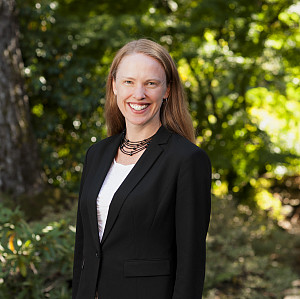main content Doing a Skin Check? Confidence Is Key
OHSU and Lewis & Clark lead the first population-based survey of melanoma literacy in the United States. A follow-up study using social media ads reveals that combining melanoma education and self-efficacy is the best health communication strategy.

It’s summer and time to enjoy the sunshine. But it’s also important to do so safely. Skin cancer is the most common form of cancer in the United States—and it’s most commonly caused by sun exposure. Research has shown that skin self-awareness and regular skin self-examinations are strongly linked to better treatment outcomes if you receive a skin cancer diagnosis.
As part of an effort to identify effective interventions to increase skin self-examinations and decrease melanoma deaths, faculty from Oregon Health & Science University and Lewis & Clark—along with colleagues at the Fred Hutchinson Cancer Research Center and the University of Washington—have conducted the first population-based survey of melanoma literacy in the United States.
Knowledge + Confidence
Results from 2,326 responses to the survey of 15,000 households in Oregon, Washington, and Utah point to increasing melanoma knowledge combined with strengthening skin-check confidence as having great potential to increase early detection and save lives. The research is described in an article in the journal Pigment Cell & Melanoma Research called “Melanoma literacy among the general population of three western U.S. states.”

Credit: Steve Hambuchen“The study we did with Oregon and two other states showed that, generally, people knew that they should check their own skin, but they did not feel confident that they would be able to do so successfully,” said Brian Detweiler-Bedell, professor of psychology and executive director of the Bates Center for Entrepreneurship and Leadership at Lewis & Clark. “So, there was a gap there.”
“We knew we needed to focus particularly on how to help people become more confident in their ability to check their own skin,” said Jerusha Detweiler-Bedell, professor of psychology and director of L&C’s Center for Community and Global Health.
The Detweiler-Bedells lead the behavioral science aspect of the research. The lead physician-scientist on the project is Dr. Sancy Leachman, John D. Gray Endowed Chair for Melanoma Research and Professor of Dermatology at Oregon Health & Science University’s School of Medicine.

Credit: Steve Hambuchen“With melanoma, your eyes really can be your best tool. A mole or spot on your skin that is changing in appearance—size, shape, color—is a key indicator for melanoma,” said Leachman. “And the data is clear: When melanoma is caught early, in stage 1 or 2, the five-year relative survival rate is extremely high—almost 100 percent. When it’s caught late, in stage 4, the five-year relative survival is only 35 percent! That’s why it’s so important that people are empowered to check their skin regularly, and we get the word out about the tools that can help.”
Among respondents, skin self-exam performance was most strongly associated with higher melanoma knowledge and more self-efficacy, or confidence in one’s ability to effectively complete an action.
Social Media Ads
As a next step, Dr. Leachman and the Detweiler-Bedells collaborated with faculty at the Center for Science Communications Research at the University of Oregon to develop and test a number of social media advertisements intended to increase melanoma knowledge and skin-check confidence. The results were recently published in the journal JID Innovations in an article titled “Evidence-Based Communication to Increase Melanoma Knowledge and Skin Checks.”
“If you look at the results, the true active ingredient is confidence,” says Brian Detweiler-Bedell.
“We were able to demonstrate that the combination of knowledge and confidence is important, but in particular, it is the confidence that really matters,” says Jerusha Detweiler-Bedell. “Of course, you need to know what unhealthy or potentially suspicious moles look like. But you might ignore or just not even try to check your own skin if you don’t first believe in yourself.”
More Stories

Textual Treasures
Paging Through the Past
In her Medieval Manuscripts course, Professor of English Karen Gross brings history to life with the help of Watzek Library’s rich archival collections. Students get hands-on experience with centuries-old texts as they explore the art of archival research.

Dance Moves
NYC-Based Dance Company In Step With L&C Students
The Tiffany Mills Dance Company, named for and headed by L&C’s director of dance, took part in a spring residency on campus, leading a series of community dance workshops and performing The Viola Trilogy alongside students.

Groundbreaking Science
A Quantum Leap for Physics Students
Ben Olsen, assistant professor of physics, is establishing Lewis & Clark’s first Quantum Information Science and Engineering lab to probe how unusual types of matter behave at the subatomic level. But first he and his students have to build “The Apparatus.”

Immersive Learning
Voices of Vietnamese Portland
Nhân Hàn BA ’27 and Thoan Nguyễn BA ’27, with project manager Zoë Maughan BA ’19, curated a 15-panel, bilingual traveling exhibit highlighting stories from Vietnamese Portland: Memory, History, Community, an archive documenting experiences of Vietnamese Portlanders.
